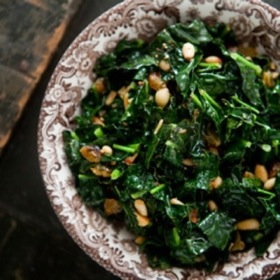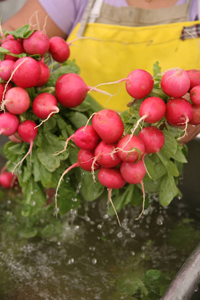
We are collaborating with fellow CSA member and founder of EZeating, Chef Tara Wood, to highlight a few recipes that use veggies from our CSA deliveries. She has collected a series of delicious recipe suggestions, so keep you eyes peeled over the next few weeks for new ways to eat your way through summer. Enjoy this recipe with this week’s Swiss Chard and Garlic!
Ingredients:
1/4 cup pine nuts
2 Tbsp olive oil
4 garlic cloves, minced
1/4 cup golden raisins
1 bunch kale, chard, collards, or turnip greens, etc., about 1 pound, tough stem centers removed (if any) and discarded, greens chopped
1/2 to 1 teaspoon red pepper flakes
Roughly 1/2 cup dry white wine or water
Salt and pepper to taste
Directions:
1. Heat a large sauté pan hot on medium-high heat and add the pine nuts. Toast them until they are fragrant and begin to brown. Pay attention as pine nuts burn easily. Stir or toss the nuts frequently. Once they are toasted, remove from pan and set aside.
2. Add the olive oil to the pan and swirl it around. Add the garlic and sauté for 30 seconds; the pan should already be hot, so it won’t take long for the garlic to begin to brown. Add back the pine nuts, add the raisins and the greens and mix well. Sauté, stirring often, until the greens wilt and begin to give up some of their water, anywhere from 1-2 minutes for spinach to 4-5 minutes for collards or kale.
3. Sprinkle a little salt and red pepper flakes on the greens. Add the white wine (can substitute water)—use a little more wine if you are cooking collards, a little less if you are cooking spinach. Toss to combine and let the liquid boil away. Once the liquid boils off, remove from heat. Add salt and pepper to taste.
Serves 2, can easily be doubled.
Image and recipe via www.simplyrecipes.com


